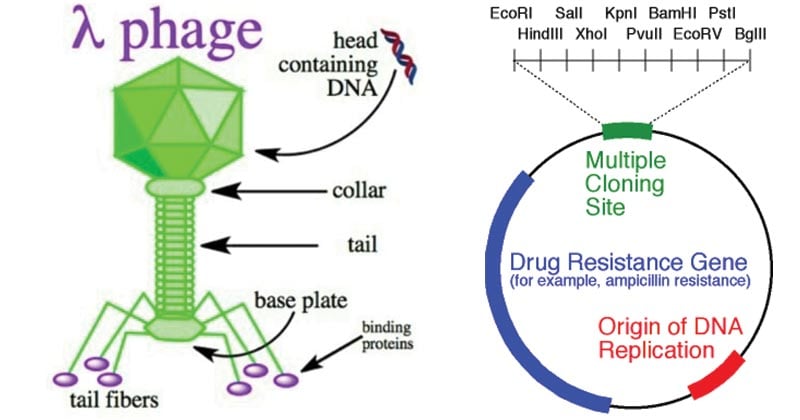- Genetic vectors are vehicles for delivering foreign DNA into recipient cells.
- In molecular cloning, a vector is a DNA molecule used as a vehicle to artificially carry foreign genetic material into another cell, where it can be replicated and/or expressed.
- Vectors can replicate autonomously and typically include features to facilitate the manipulation of DNA as well as a genetic marker for their selective recognition.
- The different types of vectors available for cloning are plasmids, bacteriophages, bacterial artificial chromosomes (BACs), yeast artificial chromosomes (YACs) and mammalian artificial chromosomes (MACs).
- The cloning vectors are limited to the size of insert that they can carry. Depending on the size and the application of the insert the suitable vector is selected for a particular purpose.

Interesting Science Videos
Essential Characteristics of Cloning Vectors
Regardless of the selection of a vector, all vectors are carrier DNA molecules. These carrier molecules should have a few common features in general such as:
- It must be self-replicating inside host cell.
- It must possess a unique restriction site for RE enzymes.
- Introduction of donor DNA fragment must not interfere with replication property of the vector.
- It must possess some marker gene such that it can be used for later identification of recombinant cell (usually an antibiotic resistance gene that is absent in the host cell).
- They should be easily isolated from host cell.
Plasmids
- Plasmids are extra chromosomal circular double stranded DNA replicating elements present in bacterial cells.
- Plasmids show the size ranging from 5.0 kb to 400 kb.
- Plasmids are inserted into bacterial calls by a process called transformation.
- Plasmids can accommodate an insert size of upto 10 kb DNA fragment.
- Generally plasmid vectors carry a marker gene which is mostly a gene for antibiotic resistance; thereby making any cell that contains the plasmid will grow in presence of the selectable corresponding antibiotic supplied in the media.
Bacteriophage
- The viruses that infect bacteria are called bacteriophage. These are intracellular obligate parasites that multiply inside bacterial cell by making use of some or all of the host enzymes.
- Bacteriophages have a very high significant mechanism for delivering its genome into bacterial cell. Hence it can be used as a cloning vector to deliver larger DNA segments.
- Most of the bacteriophage genome is non-essential and can be replaced with foreign DNA.
- Using bacteriophage as a vector, a DNA fragment of size up to 20 kb can be transformed.
Bacterial artificial chromosomes (BACs)
- Bacterial artificial chromosomes (BACs) are simple plasmid which is designed to clone very large DNA fragments ranging in size from 75 to 300 kb.
- BACs basically have marker like sights such as antibiotic resistance genes and a very stable origin of replication (ori) that promotes the distribution of plasmid after bacterial cell division and maintaining the plasmid copy number to one or two per cell.
- BACs are basically used in sequencing the genome of organisms in genome projects (example: BACs were used in human genome project).
- Several hundred thousand base pair DNA fragments can be cloned using BACs.
Yeast artificial chromosomes (YACs)
- YACs are yeast expression vectors.
- A very large DNA fragments whose sizes ranging from 100 kb to 3000 kb can be cloned using YACs.
- Mostly YACs are used for cloning very large DNA fragments and for the physical mapping of complex genomes.
- YACs have an advantage over BACs in expressing eukaryotic proteins that require post translational modifications.
- But, YACs are known to produce chimeric effects which make them less stable compared to BACs.
Human artificial chromosomes (HACs)
- Human artificial chromosomes (HACs) or mammalian artificial chromosomes (MACs) are still under development.
- HACs are microchromosomes that can act as a new chromosome in a population of human cells.
- HACs range in size from 6 to 10 Mb that carry new genes introduced by human researchers.
- HACs can be used as vectors in transfer of new genes, studying their expression and mammalian chromosomal function can also be elucidated using these microchrosomes in mammalian system.
Other Types of Vectors
All vectors may be used for cloning and are therefore cloning vectors, but there are also vectors designed especially for cloning, while others may be designed specifically for other purposes, such as transcription and protein expression.
Expression Vectors
Vectors designed specifically for the expression of the transgene in the target cell are called expression vectors, and generally have a promoter sequence that drives the expression of the transgene. Expression vectors produce proteins through the transcription of the vector’s insert followed by a translation of the mRNA produced.
Transcription Vectors
Simpler vectors called transcription vectors are only capable of being transcribed but not translated: they can be replicated in a target cell but not expressed, unlike expression vectors. Transcription vectors are used to amplify their insert.
Uses of Vectors
Vectors have been developed and adapted for a wide range of uses. Two primary uses are:
(1) to isolate, identify, and archive fragments of a larger genome
(2) to selectively express proteins encoded by specific genes.
Vectors were the first DNA tools used in genetic engineering, and continue to be cornerstones of the technology.
References
- https://nptel.ac.in/courses/102103017/pdf/lecture%2035.pdf
- https://www.nature.com/subjects/genetic-vectors
- https://www.sciencedirect.com/topics/agricultural-and-biological-sciences/vector-molecular-biology
- https://www.britannica.com/science/recombinant-DNA-technology#ref964476
- https://en.wikipedia.org/wiki/Vector_(molecular_biology)

thank u soo much for this
sagar sir u r great,,thanks a lot for making these blogs ,,, loL sir